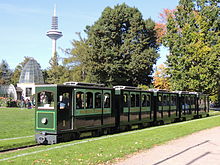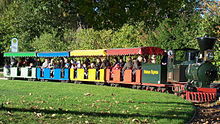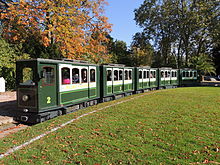Palm Express
The Palmen-Express is a park railway in the Palmengarten Frankfurt . The narrow-gauge railway has been running regularly from April to October since 1972. Depending on requirements, the driving season can either be shortened or extended.
First runway 1881
From May to September 1881, an electrically operated train ran as part of the General Patent and Design Protection Exhibition in the Palmengarten . The train corresponded to the one that had been used in 1879 with the first electric locomotive from Werner Siemens at the Berlin trade fair at the Lehrter station by Siemens & Halske . The railway was operated in the eastern part of the Palmengarten on a circuit with a track width of 550 mm and a speed of 7 km / h . The locomotive with an output of 2.2 kW was charged with direct current of 150 V operated. The power supply was provided by a busbar .
Railway systems
1972 to 2011
The railway was opened in 1972 between the terminus of the boat pond, past the rhododendron garden , flower meadow and bamboo and the Leonhardsbrunn playground and has a track width of 600 mm. The single-track line was 650 m long. At both ends the train changed the direction of travel in a turning loop until the end of the season in October 2011 , one of which led around the Papageno Music Theater , which opened in 1997 . The Bootsweiher stop was later renamed to Spielplatz and the Spielplatz Leonhardsbrunn stop to Spielwiese. Originally, the locomotive and its wagons were parked in a tunnel in the middle of the line at night and outside the driving season . After 1980 a new engine shed was built off the line .
From 2012
In the area of the Papageno Music Theater, renovations were made in the palm garden in 2012. Direct access to the theater was created from Zeppelinallee . As a result of these modifications, the previous turning loop around the music theater was no longer required from the 2012 driving season. At the same time, a new wooden operating building was also built as a terminal station and vehicle depot . The abandoned playground stop has been replaced by the new covered train station stop with a platform in the terminus . The Turkali architects' office created the atmosphere of a train station hall with the help of a standard greenhouse construction and continuous glazing of the roof. The building has a largely closed facade made of vertical larch wood boards . The platform side has 12 closable passages, 8 of which are the height of children and a station clock from Deutsche Bahn AG . In addition, the track systems were renewed. The palm garden invested a total of two million euros. The route for a single journey starts at the Bahnhof stop and ends at the Spielwiese stop in the turning loop there. The journey of the train leads through the rhododendron garden, passes the perennial garden, the Villa Leonhardi, the house Leonhardsbrunn and ends at the water playground. The travel time between the two terminal stops takes about 6 minutes. In addition to the regular trips, special trips are also offered.
vehicles
1972 to 2011
The first train of 1972 consisted of a battery - locomotive of fescue in Leverkusen with the wheel arrangement 2'B, so a bogie with two axles and two connecting rods coupled driving wheels . The exterior of the locomotive was a Western - steam locomotive modeled. In a real steam locomotive, one drive wheel set would have been driven directly from the cylinders via the drive rod and the other indirectly via the coupling rod. However, this locomotive was actually powered by an electric motor on the two drive axles. The cylinders and rods not needed for the actual propulsion were only dummies , just like the tender , which did not have to transport fuel . For passenger transport the Tender and four open served summer cars in red, yellow, blue and green with two axle bogies. The train drove through the park at about 5 km / h from the start. The original 20-minute intervals based on a timetable were replaced by on- demand traffic in the period up to 1984 . This original Palmen Express train last ran on October 16, 2011. This train was sold to Hanover for 10,000 euros .
Technical specifications
| Parameter | locomotive | tender | dare | Train (total) |
|---|---|---|---|---|
| Construction year | 1972 | 1972 | 1972 | 1972 |
| last general inspection | 03/2000 | 03/2000 | 03/2001 (car 1 and 4) 03/2002 (car 2 and 3) |
- |
| Type |
Cardan locomotive type CEL 20 with electric drive |
- | - | - |
| Wheel alignment | 2 B | - | - | - |
| own weight | approx. 2,850 kg | 600 kg | 600 kg | 5,850 kg |
| Traffic load | - | 1,200 kg | 1,200 kg | 5,400 kg |
| Weight of the fully occupied train | - | - | - | 11,150 kg |
| length | 4,250 mm | 2,500 mm | 3,600 mm | 21,150 mm |
| height | 2,030 mm | 1,800 mm | 1,800 mm | 1,800 mm |
| width | 1,100 mm | 1,100 mm | 1,100 mm | 1,100 mm |
| Center distance | 1,000 mm | - | - | - |
| Bogie spacing | - | 1,300 mm | 2,400 mm | - |
| Driving wheel diameter | 450 mm | - | - | - |
| power | 7.5 kW / 10.2 PS | - | - | - |
| speed | 6 km / h | - | - | - |
| Gauge | 600 mm | 600 mm | 600 mm | 600 mm |
| Ø mileage / year | - | - | - | 4,500 km |
| Mileage 1972–2002 | - | - | - | approx. 135,000 km |
From 2012
For the sailing season in 2012 which placed special machines SLZ-Maschinenbau GmbH in Hanau in individual production , a new multiple unit built.
Idol
The new train is in its design one of the world's first commercial electric used tram - railcars of Frankfurt-Offenbach Tramway Society (FOTG) Siemens & Halske and Herbrand & Cie. based on an idea of the then Frankfurt environment officer Manuela Rottmann . The meter-gauge model ran from 1884 to 1906 between the Old Bridge in Frankfurt-Sachsenhausen and Mathildenplatz in Offenbach am Main . One of these vehicles from 1884 is now with a sidecar in the Frankfurt am Main Transport Museum in Frankfurt-Schwanheim .
New move
Due to the elimination of the turning loop on Zeppelinallee, a bidirectional vehicle was required that could be used as a push-pull train at one end of the route . This vehicle had its maiden voyage on April 2, 2012 in the palm garden with the director of the palm garden Matthias Jenny. The new battery-powered multiple unit has two powered end cars with the numbers 1 and 2. These each have a driver's cab at one end and run on two two-axle bogies . In addition, the train consists of at least two intermediate cars , which can be supplemented by a maximum of two additional intermediate cars. A maximum of 60 passengers can be carried at the same time. All used cars with the numbers 3, 4, 5 and 6 also have two two-axle bogies, which is a per car wheel , driven in addition with a Besandungseinrichtung for the wheels is provided. Two of the cars have a wheelchair ramp for barrier-free access for wheelchair users and prams . After initial difficulties due to technical problems with the prototype in the 2012 driving season, the Palmen-Express had to undergo several visits to the workshop until August 2012 to carry out necessary rework. More than 100,000 of the up to 800,000 visitors to the Palmengarten use the Palmen-Express every year. During the warmer months, part of the window panes is removed in order to ensure pleasant air circulation while driving.
Power cars 1 and 2 consist of a driver's cab and a passenger compartment. Both are separated by a plastic disc. The passenger compartment has two bench seats with four seats each, separated by a space in between. The space in between is barrier-free and can be used for prams or wheelchair users. Access is through large double doors in the passenger compartment. Both power cars have a wheelchair ramp . The individually driven intermediate cars 3, 4, 5 and 6 are each set up identically. Each car has three compartments , each with 2 bench seats arranged opposite one another. The compartments are accessed via two sliding doors. Each car can accommodate up to 12 people. In the slightly warmer months, the windows in each of the six doors of the center car are removed.
Technical specifications
| Parameter | Power end 1 and 2 | Wagons 3, 4, 5 and 6 | Train (total) |
|---|---|---|---|
| Construction year | 2012 | 2012 | 2012 |
| Wheel alignment | B'B ' | B'B ' | B'B '+ B'B' + B'B '+ B'B' + B'B '+ B'B' |
| own weight | 3,000 kg | 2,700 kg | 16,800 kg |
| total weight | 3,400 kg | 3,600 kg | 21,200 kg |
| Body length | 4,000 mm | 4,000 mm | 24,000 mm |
| Length including coupling | 4,549 mm | 4,489 mm | 27,054 mm |
| Short train 1 | 2 | 1 | 13,500 mm |
| Short pull 2 | 2 | 2 | 18,000 mm |
| Short train 3 | 2 | 3 | 22,500 mm |
| Execution | 2 | 4th | 27,054 mm |
| height | 2,309 mm | 2,309 mm | 2,309 mm |
| Width in front | 1,000 mm | 1,200 mm | 1,000 mm |
| Width at the back | 1,200 mm | 1,200 mm | 1,000 mm |
| Compartments | 2 | 3 | 16 |
| Special compartments | 1 | - | 2 |
| Seats | 4th | 12 | 56 |
| speed | 6 km / h | 6 km / h | 6 km / h |
| Gauge | 600 mm | 600 mm | 600 mm |
literature
- Dieter Höltge, Günter H. Köhler: Trams and light rail vehicles in Germany . 2nd Edition. 1: Hessen. EK-Verlag , Freiburg 1992, ISBN 3-88255-335-9 , p. 152 (First edition: Describes the Siemens train from 1881 and the original Western train, status from 1984).
Web links
- Welcome to the Palmen-Express in Frankfurt's Palmengarten. In: website. Hendrik Schweiger Parkbahnbetrieb, Wiesbaden, accessed on November 19, 2018 .
- By train across the garden - Palm Express. In: website. Palmengarten of the City of Frankfurt am Main, accessed on November 19, 2018 .
- Search Results for: Palmengarten. In: Website of the manufacturer SLZ-Maschinenbau. SLZ Maschinenbau GmbH, accessed on November 19, 2018 .
- Maiden voyage of the Palmen-Express in Frankfurt's Palmengarten. In: YouTube website . rheinmaintv , October 31, 2012, accessed on November 19, 2018 .
- Lukas Gedziorowski and Stephan Loichinger: Palmenexpress - full steam ahead for the little ones. In: fr-online.de. Frankfurter Rundschau , April 3, 2012, accessed on November 19, 2018 .
- Catrin Häusser: Palmengarten Frankfurt- Das Zügle in the Palmengarten was a hit. Frankfurt mit Kids, May 10, 2018, accessed on November 19, 2018 .
- Christian Eblenkamp: Train station in the palm garden. In: Company website. Turkali Architects - Professor Zvonko Turkali Architect BDA , 2012, accessed November 19, 2018 .
Individual evidence
- ↑ a b c Dieter Höltge, Günter H. Köhler: Street and light rail vehicles in Germany . 2nd Edition. 1: Hessen. EK-Verlag , Freiburg 1992, ISBN 3-88255-335-9 , p. 152 .
- ↑ Christian Eblenkamp: railway station in the palm garden. In: Company website. Turkali Architects - Professor Zvonko Turkali Architect BDA , 2012, accessed November 19, 2018 .
- ↑ a b c d Lukas Gedziorowski and Stephan Loichinger: Palmenexpress - full steam ahead for the little ones. In: fr-online.de. Frankfurter Rundschau , April 3, 2012, accessed on November 19, 2018 .
- ↑ Hendrik Schweiger: Welcome to the Palmen-Express in the Frankfurt Palmengarten - special trip. In: Company website. Hendrik Schweiger Parkbahnbetrieb, 2018, accessed on November 19, 2018 .
- ↑ Hendrik Schweiger: Technology: To the technology of the former palm express. In: Website of the park railway Palmen-Express . Hendrik Schweiger Parkbahnbetrieb Wiesbaden , 2012, accessed on September 30, 2013 .
- ↑ Maiden voyage of the Palmen-Express in the Frankfurt Palmengarten. In: YouTube website . rheinmaintv , October 31, 2012, accessed on November 19, 2018 .
- ↑ Hendrik Schweiger: News / Dates / Memories “Make new out of old” or: The new train looks pretty old. In: Website of the park railway Palmen-Express . Hendrik Schweiger Parkbahnbetrieb Wiesbaden , 2012, accessed on September 30, 2013 .
- ↑ Hendrik Schweiger: Welcome to the Palmen-Express in Frankfurt's Palmengarten - season. In: Company website. Hendrik Schweiger Parkbahnbetrieb, 2018, accessed on November 19, 2018 .
- ↑ a b Hendrik Schweiger: Train and Technology. In: Website of the park railway Palmen-Express . Hendrik Schweiger Parkbahnbetrieb Wiesbaden , 2012, accessed on November 19, 2018 .
Coordinates: 50 ° 7 ′ 24 ″ N , 8 ° 39 ′ 29 ″ E





